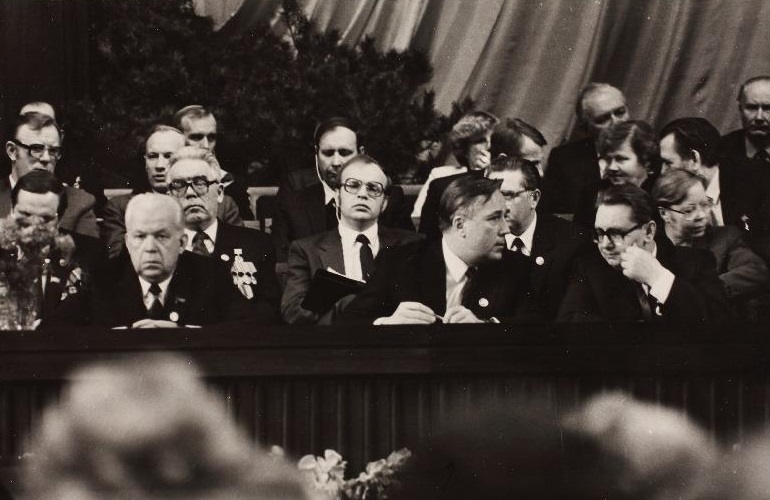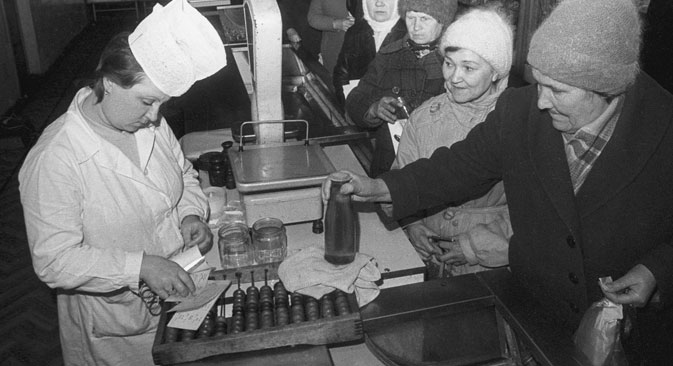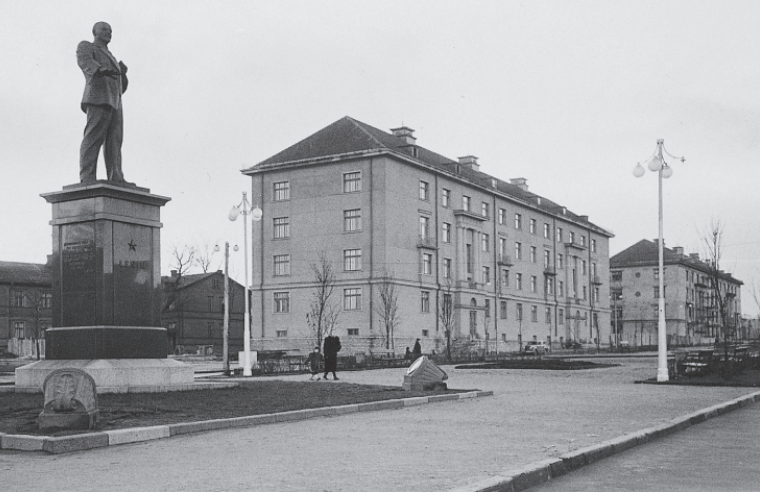The Elite and Their Privileges in the Soviet Union
The existing gap between the privileged elite and everyone else in the Soviet Union showed that the communist ideal of social equality remained an empty slogan.
Although the official ideology in the Soviet Union was egalitarianism, the society was rife with inequality and discrimination. It was the various marginal and marginalised groups of the communist empire that suffered the most. However, socioeconomic inequality was a phenomenon that a large part of the population experienced day in day out. The main reason was the privileged status of certain social groups.
The objective of this paper is to examine the privileges that accompanied social or official positions and were acquired with the help of such positions, giving the chosen few access to social and economic benefits, which were completely or mostly unattainable for the rest of the people.

Often privileges are only viewed in connection with the nomenklatura, which has been turned into a myth by some authors, like the historian and political scientist Mikhail Voslensky, who emigrated from the Soviet Union and the well-known Yugoslav communist Milovan Đilas. They were disappointed in the system and became its critics. Both saw the nomenklatura as the „new class” or „ruling class” and used the term in the narrow sense of the word to denote only the Soviet elite. Such an approach is too simplistic and fails to consider the formal hierarchies and social strata within the nomenklatura and leaves aside several social groups that cannot be ignored when studying the functioning of the system of privileges.
In the narrow sense, nomenklatura can be defined as a (secret) list of the key posts to which people were appointed and from which they were released on the basis of a decision or approval of the communist party committee (following the example of the party, government institutions started to develop their own nomenklatura lists). In the ordinary meaning members of the nomenklatura were just persons who filled such listed posts; they could be holding leading positions in the party apparatus, ministries, research or cultural institutions.
Just like the nomenklatura was not the same as the privileged elite, the list of posts was not required for assigning benefits. The nomenklatura was primarily the control mechanism of the party, which allowed the cadres’ policy to be used by the higher party echelons to interfere in the activities of the lower party organs and the party organs to interfere in the activities of state institutions and other organisations.
One of the features characterising the nomenklatura was its hierarchical order. All the communist party organs had their own nomenklaturas: the Central Committee of the Communist Party of the Soviet Union (CPSU CC), union republic communist party central committees and regional communist party committees (in the case of the Estonian SSR the latter were the city and district (raion) communist party committees).

All the levels of the nomenklatura had their own, internal hierarchies, e.g. „main” nomenklatura or list of posts, where the appointments and dismissals had to be approved by the relevant party committee and „accounting” nomenklatura, where the party just had to be informed of appointments and dismissals. Party bureaus and secretariats also had their own nomenklaturas. Therefore, the formal status of a department head of the Central Committee of the Estonian Communist Party (ECP CC) is not comparable to that of the department head of a district executive committee, for the former was listed in the ECP CC nomenklatura and the latter in the district party committee nomenklatura.
The political and social influence of posts within the nomenklatura of the same level and the extent of privileges they were entitled to was considerably more important. In the ECP CC nomenklatura (with ca 1,500-2,000 posts) the highest status was enjoyed by members of the ECP CC Bureau, but members of the ECP CC also stood above others. Similarly, the staff of the central authorities of a union republic differed by their status from the district level party and executive committee cadres, who had to follow the orders of the former. There were some differences in the privileges within one level of the nomenklatura, and major differences between the various levels.
As regards their socioeconomic meaning, privileges could be classified according to their legal and regulatory standing. Based on this, it is possible to distinguish three categories of socioeconomic privileges: public-normative (legally regulated), administrative-bureaucratic (i.e., these were more or less secret or unwritten entitlements) and „unofficial” privileges, which in reality meant access to distribution channels of goods and services on account of the person’s post or position.
This created favourable conditions for the distribution, channelling and acquisition of „deficit” goods and services (i.e. those in short supply) and other benefits. Such activities did not necessarily have to be illegal, but they certainly were not legal either; still, as the situation with shortages worsened, such behaviour became a social norm. This did not reduce social or economic inequality but created an ideal environment for abuse, corruption and speculation.

It is difficult to present an exhaustive list of sectors and posts with „unofficial” privileges, but such a list should definitely include staff of shops and catering enterprises, medical doctors, seamen, officials of executive committees dealing with utility services and housing, and administrative staff of state organs and enterprises.
Many employees of the Council of Ministers Administrative Department could enjoy the „unofficial” privileges, for this was the body in charge of providing goods for special shops only designed for the nomenklatura, as well as assigning plots for summer cottages and handing out holiday-related benefits to them. In other words, this body was distributing administrative-bureaucratic benefits. On the other hand, the trade union staff mostly dealt with the general population, allocating apartments, permits to purchase cars and holiday vouchers, which were all very hard to come by and one had wait for years for one’s turn.
The following social groups were enjoying significant public-normative and administrative-bureaucratic privileges: the communist party apparatus, ministers, top managers of state institutions, top-level athletes, leading members of the creative intelligentsia and scientists, party and war veterans, deputies of the Supreme Soviet. With some reservations, they all could be viewed as belonging to the Soviet elite.
Upper party and government echelons and the chosen few from the creative intelligentsia were awarded free holiday vouchers for staying in the resorts designed respectively for the party and government apparatchiks and members of artistic associations.
Speaking about socioeconomic privileges in Soviet society, it is necessary to understand that they were, to a great extent, driven by the socialist economic system, which formally was based on a planned economy, but in essence was a command economy. Generally, the system was extremely inefficient and the combined impact of different factors led to a permanent shortage of consumer goods, various services and, to a lesser extent, food. Although there were food products, especially imported foods, that were always in short supply.
The first thing that should be mentioned when discussing the privileged groups is their higher incomes in comparison with the general population. However, in comparison with the capitalist countries, differences in incomes were not too significant. The managerial staff did not make that much more in basic wages than ordinary workers (the levels were set by the state), but various fringe benefits and bonuses paid to managers could make a big difference in their incomes.
Widely used was the thirteenth salary, also called „health pay”, which was paid when employees took their annual leave. It is not known how many communist party and state institutions used the thirteenth salary.
However it is known that upon restoration of independence, the Republic of Estonia state and municipal authorities continued to use the system and it was still there in the early 2000s. The thirteenth salary was given to all employees irrespective of their position. Additional pay for the knowledge of foreign languages and academic degrees was also taken over by the Republic of Estonia from the Soviet period and was a source of extra income for civil servants in particular.
There were also different pension schemes. There was a system of personal pensions in the Soviet Union, with three levels: all-Union, republican and local personal pensions. The amounts paid to personal pensioners were higher than the wages of an ordinary employee. Mervyn Mathews has studied the Soviet privileges and according to him a personal pensioner of all-Union importance was paid 2,000 roubles in 1956, whereas the average wages at the time were only 720 roubles. In addition, personal pensioners paid less for utilities and medicines, but such costs were not too high anyway.
An income tax exemption was another benefit the privileged were entitled to. In the years following World War II and again after Brezhnev came to power, Heroes of the Soviet Union, Heroes of Socialist Labour and other recipients of state decorations did not have to pay income tax. However, income tax exemptions could be extended to other social groups as well, e.g. members of the creative intelligentsia.
Upper party and government echelons and the chosen few from the creative intelligentsia were awarded free holiday vouchers for staying in the resorts designed respectively for the party and government apparatchiks and members of artistic associations. In addition to free meals and accommodation, their travel costs were also reimbursed. In light of this, free public transport for deputies of the Supreme Soviet and personal pensioners is not even worth mentioning.
„Deficit” plays a role in supplying goods for the Soviet elite as well. Although holders of key posts earned more than regular employees, they could end up paying less for „deficit” goods than had they bought it from a regular shop. Primarily this applied to special food parcels, the so-called kremlyovkas, which only about a dozen Estonian top party and government apparatchiks could get, paying only a symbolic price for them. In addition, there were special shops, not accessible to ordinary people, in major Soviet cities and republican capitals, selling imported goods.
Also, the living conditions of the Soviet elite could differ from those of the general population. The top nomenklatura in the Estonian SSR preferred the more prestigious apartments built before World War II, where they were usually allocated more space than established by the relevant norms. Detached houses in prestigious residential areas were also well sought after.

Apartment blocks were built in major Estonian cities for employees of the various authorities and enterprises, but also for members of artistic associations and scientists. Sometimes these have been erroneously referred to as apartment houses for the nomenklatura.
Finally, let us look at the health care services provided for the elite. In Tallinn, there was the Republican 4th Hospital, also known as the Party Hospital. The party and government officials of the union republic, members of the privileged creative intelligentsia and scientists, party and war veterans etc., received treatment at this hospital. In some cases, their families were also entitled to medical help there.
When a leading party or government officials died or personal pensioners finished their earthly course, the surviving spouse and underage children could be given one-off benefits in addition to the funeral benefit. However, quite often the children received benefits until they became of age and spouses were awarded survivor’s benefits for life.
Nomenklatura was abolished as the Communist Party lost its monopoly of power and the Soviet Union collapsed. Some of the former union republics maintained a certain amount of the formal privileges for the elite, „unofficial” privileges survived in many places, but everywhere there were representatives of the former elite, who took up positions among the political and economic elite of the new societies.
Olev Liivik (born in 1975) is an Estonian historian and senior researcher at the Estonian Institute of Historical Memory. His main research interests include the political history of post-World War II Estonia and the history of the Baltic German minority in Estonia in the 1920s and 1930s.
Literature:
Djilas, Milovan. The new class: an analysis of the communist system. New York 1957.
Hämäläinen, Mariliis. Eestimaa Kommunistliku Partei Keskkomitee nomenklatura 1945–1953. Tartu 2011.
Lankots, Epp. Klassid klassideta ühiskonnas. Elitaarne ruumimudel Eesti NSV-s ja nomenklatuursed korterelamud Tallinnas 1945-1955. – Kunstiteaduslikke Uurimusi/ Studies on art and architecture, 2004, No 2, pp 11−41.
Leito, Toomas. Tagasivaated. Tallinn 2020.
Liivik, Olev. Nõukogude ajaloo mõisted ajaloolaste hambus. – Kultuuri KesKus, (November 2009), pp 48–49.
Matthews, Mervyn. Privilege in the Soviet Union: A study of elite life-styles under communism. London 1978.
Meri, Hindrek. Tagasivaateid veerevast vagunist. Tallinn 2010.
Ott, Margus. Nõukogude ebavõrdsusest. Postimees, 17.03.2018.
Tannberg, Tõnu. Moskva institutsionaalsed ja nomenklaturased kontrollimehhanismid Eestis NSV-s sõjajärgsetel aastatel. – Eesti Ajalooarhiivi toimetised Tartu 2007, pp 225–272.
Voslensky, Michael. Nomenklatura. The Soviet Ruling Class. New York 1984.